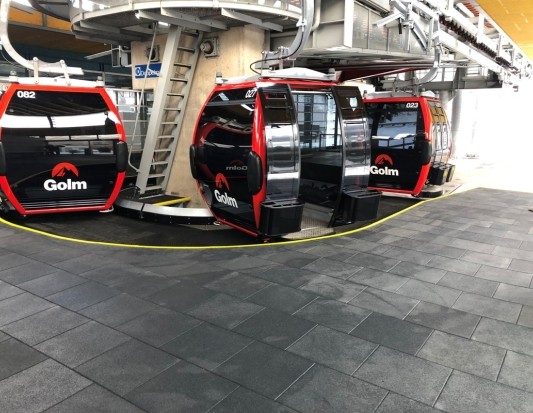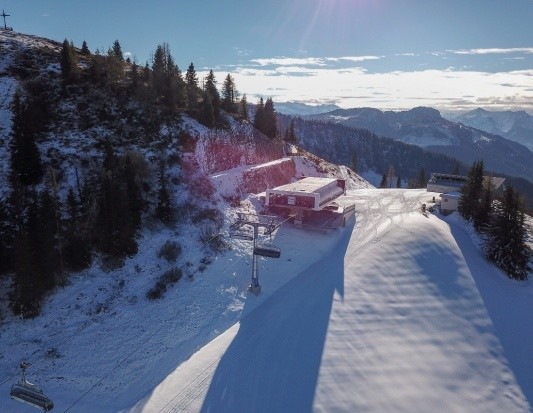GASTEINER MOUNTAIN Ropeways
Gastein
Investing with a Strategic Plan and Extending the Lifespan
When faced with the challenge of unavailable spare parts for nearly a dozen ropeways, Gasteiner Bergbahnen had to devise a solution. Following the discontinuation of support for products from STG Steuerungstechnik at the end of 2019 and the pending decision on renewing the nearly 30-year-old Sendleiten 4-seater ropeway, Gasteiner Bergbahnen found themselves in a difficult situation exacerbated by the impact of the Corona crisis on the tourism industry.
In order to make informed decisions, Gasteiner Bergbahnen recognized the need for a solid foundation. They enlisted the services of Salzmann Ingenieure to develop a comprehensive master plan for the ski area and conduct a risk analysis of the STG controls. For the Sendleiten ropeway, the engineering firm from Bregenz examined various options, resulting in significant cost savings amounting to millions of euros and a clear prioritization of future investments.
The initial situation was challenging. Half of the 22 mountain ropeways in the Gastein ski area relied on control systems from STG. With the company's closure and the retirement of the last STG technician in 2019, obtaining spare parts became increasingly difficult. Resort operators were forced to procure used spare parts, which proved to be an unsustainable solution.
Replacing the control systems in all eleven affected installations immediately would have required multimillion-euro investments in older ropeways, which Gasteiner Bergbahnen deemed unfeasible. However, the loss of critical ropeways during the season was also not an option. Moreover, there were concerns about the future development of the entire ski area. With a recent investment of 70 million euros in the new Schlossalm ropeway and plans for a new 8-seater ropeway on the existing Sendleiten route in 2020 (costing 15 million euros), the impact of the Corona crisis further heightened the need for careful examination of upcoming investments.
Wolfgang Egger, CEO of Gasteiner Bergbahnen, emphasized the necessity to scrutinize future investments under the circumstances. The crisis compelled them to seek transparency and establish a solid basis for making well-founded decisions, as expected from their management team.
To achieve this, Gasteiner Bergbahnen engaged the expertise of Salzmann Ingenieure, with whom they had a longstanding collaboration. The Bregenz-based planning office embarked on creating a master plan for the ski area, with a focus on ropeways, and conducting a risk analysis of the STG controls. Their role involved evaluating and structuring the internal project ideas of Gasteiner Bergbahnen, while also providing an external expert perspective, as described by Managing Director Stephan Salzmann.
Through detailed site visits and meetings, the potential for improvement was thoroughly analyzed. This laid the groundwork for a preliminary study encompassing various ropeway and slope project alternatives. Each ropeway was meticulously examined, considering factors such as its age, transport capacity, comfort, available slopes, and integration into the primary routes for skiers. Ultimately, the question posed was: How would this ropeway be designed if it were constructed today? The Bregenz planners also devised a station concept for each individual station.
Project ideas that were deemed infeasible were eliminated. Once all the projects were gathered, Salzmann Ingenieure collaborated with Gasteiner Bergbahnen to establish a prioritization. CEO Wolfgang Egger firmly believes in the value of such an analysis, stating, "If we construct a station in an incorrect location today, it will remain there for the next 35 years. We have learned that continuous evaluation of alternatives is necessary to identify the optimal choice."
Retrofitting as the preferred solution This precise approach was applied by Gasteiner Bergbahnen to the Sendleiten 4-seater ropeway. The proposed renewal of the ropeway along the existing route had already received approval as part of the environmental impact assessment for the Schlossalmbahn. However, the anticipated increase in passenger numbers following the implementation of the Schlossalmbahn did not materialize as expected. Board member Wolfgang Egger explains, "In the first two winters, we observed that guests often ski directly down to the valley using the new slopes instead of descending to the Sendleiten ropeway."
This prompted a reassessment of the 15-million-euro investment. Salzmann Ingenieure thoroughly examined five alternatives, ranging from continued operation without immediate investment to retrofitting the existing ropeway or replacing it with a 4-seater, 6-seater, or 8-seater chairlift.
After a comprehensive evaluation of the costs and benefits, the decision was made to proceed with retrofitting the existing ropeway. Components that had reached their wear limit or were no longer supported by spare parts were replaced. This approach ensured the operational viability of the ropeway until its general overhaul in 2032.
Christian Hochreiter, the technical manager for the Bad Hofgastein area, expresses confidence in the retrofitting project, stating, "Through the refurbishment, costing 1.4 million euros, we have made the most favorable medium-term solution for the Sendleiten ropeway. The possibility of a complete reconstruction in the long term remains, with the necessary permits already in place."
Mitigating risks and expenses
The first step in replacing the STG controls involved conducting a comprehensive risk analysis. Salzmann Ingenieure, in collaboration with the responsible operations team, assessed the condition of the control systems. They estimated the likelihood of potential malfunctions and researched the availability of spare parts. Additionally, the analysis considered the impact of a ropeway failure on the ski resort.
Once again, a clear prioritization emerged from this process. Between 400,000 and 800,000 euros per year will be allocated for the renewal of control systems until 2023. This approach ensures the continued operation of the facilities at a reasonable cost while minimizing operational risks.
Stephan Salzmann, Managing Director of Salzmann Ingenieure, expresses satisfaction with the outcome, stating, "We are pleased that, similar to the slope equipment, the lifespan of the ropeways will be significantly extended. As we all know, every euro can only be spent once, and it is crucial that we optimize its utilization for the benefit of our guests."
























